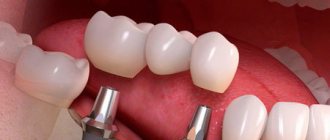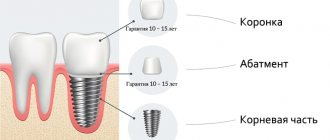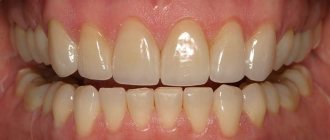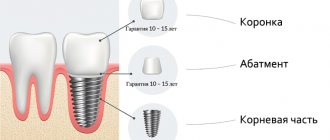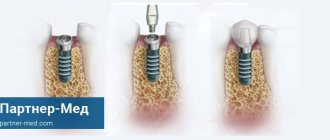Implantation is a modern method of dental restoration that allows you to restore a beautiful and confident smile. It can be used when one, several or even all teeth are lost. The technique has proven itself and has been successfully used for many years.
However, some patients do not decide to undergo implantation because they think it is a very difficult and painful procedure. Yes, indeed, the classic method of dental implantation involves surgery and a fairly long recovery period. But besides this, there are other methods, for example, implantation without a gum incision.
Installing a dental implant without making a gum incision – is it possible?
A dental implant is placed directly into the jawbone to replace the lost root. To install it, you need to cut the gum tissue and open access to the bone. After implantation of the titanium root, the gum is sutured.
New technologies make it possible to carry out the implantation procedure without making a gum incision
With the development of implantation technologies, the need to make an incision has disappeared. Now the implant can be installed without using a scalpel. Using special equipment, the doctor makes a small puncture in the gum and inserts the implant through it.
Implantation without an incision is also called bloodless or seamless. In European countries, which were the first to use this technique, it is known as “transgingival implantation”.
Where the truth ends and advertising begins: the disadvantages of non-surgical implantation
Perhaps the biggest disadvantage of the so-called “non-surgical” implantation is, no matter how paradoxical it may sound, its overly exaggerated advantages. Here it is necessary to clarify several very controversial points from a medical point of view.
It is also useful to read: Complications and problems that sometimes arise after dental implantation
Firstly, any surgical intervention associated with artificial tissue damage is considered an operation, even if it is performed in the most gentle way and without sutures. So it’s hard not to call cutting out a piece of gum and subsequent drilling of the jawbone an operation.
Secondly, the method of installing an implant immediately after tooth extraction (if we talk about express dental implantation) is not suitable in all clinical cases. For example, immediate implantation cannot be performed in cases of acute inflammation, severe pain, swelling near the tooth being removed, as well as significant bone deficiency and the inability to provide primary stabilization of the implant.
Moreover, even if, according to unofficial statistics, immediate dental implantation can be carried out in 40-50% of all cases, the doctor sometimes simply cannot cope with this task. It’s simple: a dental surgeon is not always able to remove a tooth carefully (atraumatically), and as a result, the “disfigured” hole is no longer suitable for immediate implantation. If the dentist begins to carry out such implantation contrary to common sense and indications, then its success is minimal.
So, dental implantation without gum incisions, strictly speaking, does not exist: you still have to cut the gum with something and somehow. Another thing is that there are special tools that can make neat circular cuts, the diameter of which is minimal.
But even here there are pitfalls, and in a significant number of cases, transgingival implantation can be problematic for a number of reasons:
- The doctor is not fully aware of the clinical situation (he sees the patient for the first time and has not treated him before);
- Small volumes of bone tissue and mucous membrane;
- Alveolar ridge atrophy.
The experience and qualifications of the doctor are also important. The bottom line is that dental implantation is tied not only to equipment and instruments, but also to the skill of the surgeon.
Advantages of the method
Bloodless implantation has gained wide popularity due to a number of advantages that distinguish it from other methods.
- Neighboring teeth do not require preliminary grinding, as is done with other methods of prosthetics
- No need to cut the gum, minimizing the risk of injury
- The procedure itself takes a little time
- The patient does not experience pain or other unpleasant sensations
- Since the gum tissue is minimally damaged, it heals very quickly.
- The risk of implant failure is low
- The use of laser equipment can significantly increase the likelihood of titanium root survival
- During chewing, the load on the jaw is distributed evenly, which allows you to quickly restore chewing function
- Implants have a long service life. If the artificial root was installed in compliance with the technology, then it will last a very long time - from 10 years and above. In many cases, an implant can replace a lost tooth for the rest of your life.
- The cost of bloodless implantation is not much higher than the cost of classical
- The technique can be used in various clinical cases, even when the patient is completely missing teeth
Unlike other methods of dental restoration, transgingival implantation does not require a large number of doctor visits after surgery. The postoperative period is easy, without causing any particular inconvenience to the patient.
After implantation, no additional oral hygiene products are required
Oral hygiene after implant installation is no different from regular dental care. There is no need to purchase any additional hygiene products.
Rehabilitation period
After successful dental implantation, a recovery period begins, the duration of which will depend not only on the characteristics of the patient’s body, but also on his actions. If a doctor made a mistake when installing implants, complications will appear almost immediately after the procedure. But if signs of implant rejection or inflammation appear after several months or years, then only the patient is to blame.
Restrictions after implantation
The main rule is impeccable compliance with all medical recommendations and prescriptions. As a rule, they are as follows:
- refusal of active physical activity during the first 14 days after implantation. You should also avoid visiting baths and saunas;
- giving up bad habits that negatively affect the oral cavity. Regular smoking and alcohol abuse slow down the recovery processes, which is why the implant will take much longer to take root;
- uniform load on the jaw. When installing temporary dentures, you need to ensure that the load on them is minimal. This will prevent the product from moving;
- Regular use of mouth rinses. This should be done after every meal. If possible, experts also recommend using dental floss. It must be remembered that poor oral hygiene can lead to dental implant failure in the future.
Oral hygiene is very important
Even if you currently do not have any problems with your teeth, you should visit the dentist's office regularly, especially if you have previously had an implant implanted. Such examinations will identify possible problems, such as signs of implant failure, at an early stage of their manifestation. To exclude the development of serious complications, you need to contact a specialist at the first manifestation of suspicious symptoms. Only with a responsible attitude towards dental implantation can you minimize the risk of possible troubles in the future.
Indications for surgery
Seamless implantation can be performed in the following cases:
- The patient is missing one or more teeth
- The patient has no teeth at all
- It is necessary to restore lost teeth in a short period of time
- The patient has diseases, as a result of which the wounds heal very slowly, and surgical intervention is accompanied by a long recovery period
- The procedure needs to be completed in just a few visits.
Transgingival implantation takes minimal time. The entire procedure takes no more than two sessions.
At the first session, the dentist forms a dental canal and inserts an implant into it. At the second stage, after the structure has taken root and the gum tissue has healed, a crown is installed on the artificial root.
Approximately 8 weeks pass between sessions (significantly less than with the classic method of dental implantation). The procedure is low-traumatic and is therefore performed under local anesthesia.
How is it different from traditional
Traditional implantation is a surgical operation in which the doctor makes tissue incisions: he cuts the gum above the alveolar ridge using a patchwork method, peels off the mucous membrane and periosteal tissue. After screwing in the titanium rod, the gum is sutured.
In addition to being traumatic, traditional implantation is associated with a lengthy operation and the risk of negative side effects and complications. Other disadvantages include: the length of the recovery period and the need for preliminary bone augmentation if the volume is insufficient.
Advantages
— minimal tissue trauma (the gums are not cut); — taking into account the anatomical features of the structure of the jaw bone; - reduced operation time - installation of one rod takes 10 minutes; - comfort and absence of pain; - mild tissue swelling after surgery; - short recovery - on average 3 days; - minimal risk of complications.
Flaws
— template production takes 2-3 days;
- relatively high price. If surgical guides allow patients to forego bone grafting, treatment costs will be reduced. The use of surgical templates for dental implantation makes it possible to predict the outcome of treatment due to the accuracy of planning.
Sign up for a consultation
three ROOTT specialists + diagnostics as a gift
All specialists Our specialists
0:45
Voznyuk Vladimir Alexandrovich
maxillofacial surgeon-implantologist of the highest category
0:45
Malinovsky Igor Yurievich
maxillofacial surgeon-implantologist
Contraindications for surgery
Despite all its advantages, high efficiency, as well as minimal risks of complications, bloodless implantation is not allowed for everyone.
Implantation is not recommended under certain conditions, including during pregnancy.
It is not recommended for the following diseases:
- Caries, stomatitis and other oral diseases
- Severe pathologies of internal organs
- Oncological diseases
- Acute infections in the body
- Pregnancy and lactation period
- Engagement in sports in which a person has a high risk of injury (this includes boxing, wrestling and many other sports)
Seamless or, as it is also called, instant implantation is an excellent alternative to the classical method, which involves surgical intervention. The procedure allows you to restore lost teeth and regain an attractive smile in a relatively short period of time.
Advantages and disadvantages
Advantages:
- Minimal surgical intervention and a short recovery period do not cause much discomfort to the patient.
- Significant reduction in implantation time. An experienced implantologist can perform it in just a few minutes.
- Immediately after the operation, the patient has virtually no pain and swelling of the soft tissues. In this case, there is no disruption of the blood supply to the gums and bones, which significantly increases the chances of a successful outcome.
- The final prosthetics are performed on the day of implant installation. At the same time, loads can be placed on orthodontic structures almost immediately and the patient does not have to significantly change his lifestyle.
- Implantation can be performed immediately after the old tooth is removed.
- The number of doctor visits and the cost of treatment are reduced.
Flaws:
- The surgeon is not able to visually monitor the implant insertion process and the condition of the bone. Therefore, there is a risk of incorrect selection of elements.
- It is impossible to carry out implantation with small volumes of bone tissue without pre-building it.
- There are a large number of contraindications for which this method cannot be used.
With one-stage implantation, installation of the implant does not require an incision in the gum and exposure of the bone
Types of dental implantation
Installation of dental implants is a fairly common method of dental restoration, widely used throughout the world. There are different types of implantation, each of which has its own characteristics. The most appropriate method is chosen by the doctor. It evaluates the condition of the patient’s oral cavity in general and the jawbone in particular, the number of units requiring restoration, diseases the patient has and other factors. The financial capabilities of the patient also influence the choice of treatment method.
There are two main methods of dental implantation – classic two-stage and one-stage. Let's look at each of them in more detail.
Classic two-stage implantation
This method is used most often and involves two stages of the procedure.
First, a dental implant is implanted into the patient's jawbone. This is followed by a rehabilitation period, during which the artificial root takes root in the bone tissue. This will take at least three months, and maybe more (depending on the individual characteristics of the body).
After the implant has completely taken root, a crown is put on it - this is the second stage of the procedure. The peculiarity of the method is that during the period of root engraftment and tissue restoration, the load on the tooth must be eliminated.
What it is?
Dental implantation without gum incision is a progressive dental technique for restoring lost elements of the dentition. Such an implant installation guarantees:
- survival of the titanium root in the bone tissues of the jaw;
- minimizes the risk of postoperative complications during engraftment;
- extends the possible service life of the implanted implant.
The ability to perform minimally invasive surgery is provided by the use of modern technologies through computed tomography and a surgical template. Computed tomography provides accurate information regarding the anatomical features of the patient’s jaw structure. The surgical template allows you to place the implant in the jawbone at the optimal angle and with the greatest precision.
When performing dental procedures, small implants are used, which provides the following advantages:
- install implants in 1 visit to the dental office;
- minor trauma to the oral cavity;
- minimal damage to mucous membranes.
If you do not take into account advertising gimmicks, there are 2 options for performing implantation without a gum incision:
- Installation of an implant immediately after tooth extraction. In this case, there is already a hole in which it is possible to place the structure, without performing additional cutting.
- Placement of titanium root through puncture. In some dental clinics, the puncture is performed using a laser. After this, the implant is installed.
Such a procedure is possible only if there is a sufficient amount of the jaw’s own bone tissue and in the absence of contraindications.
One-stage implantation
This technique differs from the previous one in that the entire procedure occurs in one step. The doctor removes the damaged tooth, immediately installs an implant in its place, and puts a temporary crown on it. This is followed by a rehabilitation period, after which the temporary crown is removed and a permanent one is placed in its place. Materials such as metal-ceramics or ceramics are used to make crowns.
The peculiarity of the one-stage method is that immediately after visiting the doctor, the aesthetic function of the dentition is restored.
What does dental implantation include?
Patients are interested in how the dental restoration procedure is carried out and what stages they have to go through.
- Initial consultation. At the initial consultation, the doctor examines the patient, assesses his condition, calculates the number of units that need to be restored, and draws up a treatment plan. After this, preparatory work begins.
- CT scan. To perform the operation, a three-dimensional photograph of the jaw is required. Using this image, a model of the jaw is made in the laboratory, on which implants are then installed. This is necessary in order to correctly place the artificial roots in the bone tissue. In addition, the doctor examines the condition of the patient’s bone tissue and determines whether there are any contraindications to the operation.
- Real simulation. At this stage, artificial jaws are made from special materials. A computer image taken on a tomograph is taken as a sample. As a rule, jaw models are made of plastic. After this, the doctor prepares a surgical template (adjusts the instruments to a predetermined drilling depth).
- Implant installation. After all the preparatory work has been completed, you can proceed directly to installing the implant. The operation is performed under local anesthesia. The doctor places the prepared template on the patient’s jaw and performs rough drilling in the designated areas. It is important to drill into the bone correctly, at a certain angle. The template protects adjacent teeth and gum tissue from damage.
- Calibration. After drilling holes in the bone, the doctor removes the template and calibrates them, creating the desired diameter. A titanium pin is screwed into the resulting hole, and a gum former is placed on it. Sometimes a temporary prosthesis is installed instead of a former.
- Installation of a permanent prosthesis. After the operation, a recovery period is required, which takes several months. During this time, the implant will take root, and the patient will need to visit the doctor again to remove the gum former or temporary prosthesis and replace it with a permanent one. In most cases, the period of complete implant engraftment lasts 3–4 months.
Stages
The procedure for dental implantation without an incision requires only two visits to the doctor. Unlike classic implantation, the installation stages are not so extended in time.
- Preoperative period. During this stage, a complete examination of the patient is carried out, indications and contraindications for the procedure of implantation of titanium roots are identified. The selection of implants is carried out. If necessary, treatment of gums and teeth, bone tissue augmentation or sinus lifting is carried out. The duration of this period depends on the complexity of preparation for implantation and can take from several weeks to six months.
- Carrying out the operation. It is performed using local anesthesia. The procedure does not require any incisions or stitches. After installing the implant on the abutment, a temporary crown made of metal-plastic is fixed.
After one and a half to two months, after the titanium root has engrafted, permanent dental crowns are installed.
Implant placement can be done with or without a surgical guide.
Implantation using a surgical guide
Photo: Using a surgical template
For implantation without incisions, one of the types of templates is used:
- Based on the mucous membrane of the oral cavity and teeth.
- Based on the oral mucosa.
- Only with support on teeth.
3D modeling is used to produce a surgical template.
A surgical template made in a special laboratory is fixed to the jaw and implants are implanted through specially prepared holes without making an incision in the gums.
Immediately after installation of the structures, the crowns are fixed.
Implantation without the use of a surgical guide
After studying the results of a computed tomography scan, the doctor plans the implantation site “by eye”, and then proceeds with the operation.
Features of the postoperative period
The rehabilitation period is an important stage of the procedure, on which the success of the entire treatment will depend.
The timing of restoration of damaged tissues and osseointegration of the implant depends on the professionalism of the doctor, the characteristics of the patient’s body, and also the correctness of postoperative care.
During the rehabilitation period you should refrain from drinking alcohol and smoking
If the doctor installs the implant incorrectly, complications will arise almost immediately. If they appear after a few weeks or months, it means that the patient does not follow all the recommendations. To avoid rejection of the orthodontic structure or the development of an inflammatory process, the following instructions must be strictly observed:
- In the first two weeks after surgery, limit physical activity (sports, heavy physical labor), and do not visit the bathhouse or sauna.
- Do not smoke or drink alcoholic beverages. Alcohol and nicotine negatively affect the condition of the oral cavity. Under their influence, the wound will take longer to heal and may become inflamed.
- Minimize stress on your jaw. Once your temporary dentures are fitted, do not put too much pressure on them to prevent the implant from moving out of place or becoming loose.
- Maintain good oral hygiene. Brush your teeth and use special mouthwashes that kill pathogenic bacteria. After every meal, clean between your teeth with dental floss. Remember that poor hygiene can cause complications
After the implant has successfully taken root and you are given a permanent prosthesis, do not forget to visit the dentist from time to time and monitor the condition of not only natural, but also artificial teeth. Even if you have had the implant for a long time, you need to periodically show it to your doctor in order to identify possible problems in advance.
Advantages of express implantation
Immediate dental implantation (that is, immediately after the extraction of a diseased tooth) is becoming increasingly popular every year. For some specialists in this field, the number of immediate implantations is 40-50% of the total amount of work, and the success of such operations directly depends on the professionalism of the doctor and the availability of the necessary equipment in the dental clinic.
Before talking about the many advantages of immediate implantation, let us remind you once again that calling this process non-surgical, as they say, “is tongue-in-cheek.” And yes, there may not be an incision in the gums, since it is not needed, because the fresh socket of a just removed tooth itself is often suitable for installing an implant without additional manipulation with a scalpel.
It is also important to note the fact that such a one-step procedure is not suitable for everyone and not in all cases. Example: suppose a patient, for some reason, would like to have implants installed immediately after tooth extraction (influenced by advertising, reasonable cost, little time, etc.), and the doctor sees that there are signs of acute inflammation in the area of tooth extraction . In this case, the success of the event is, to put it mildly, questionable, and it is important for the doctor to explain this to the patient.
If there is a severe deficiency of bone tissue in the implantation area due to severe periodontitis or a periodontal cyst, it is also impossible to remove a tooth and install implants at the same time (due to the presence of direct contraindications to this procedure).
On a note
It is also possible to note cases that are not associated with contraindications to immediate implantation, but are closely related to the presence or absence of appropriate equipment and instruments. Not all clinics have the appropriate equipment, just as not all doctors have the technology for instant installation of implants.
When there are no contraindications to immediate implantation, and the doctor has the necessary experience and technical support, then the procedure provides significant advantages over classical implantation:
- In the case of simultaneous implantation, tooth extraction, installation of an implant and gum former are completed in one clinic visit;
- Lower cost (including in connection with the above point);
- In the area of tooth extraction, a bone tissue deficiency does not have time to form due to the long-term absence of chewing load. This means that sinus lift surgery (bone augmentation) will not be required to install the implant;
- The success rate of operations is about 99%;
- It is easier for the doctor to adjust the implant in the space of the fresh socket, which helps to correctly calculate and control the installation process, and this, in turn, has a positive effect on the final result and ease of use of future orthopedic structures (bridges, crowns, etc.).
It is also useful to read: The use of mini-implants for fixing removable dentures
